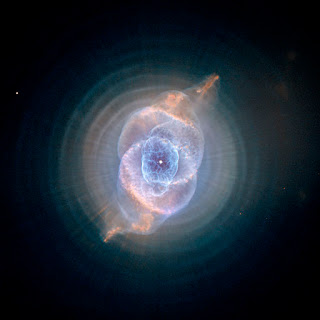People name all sorts of things after cats, and not all of
those things are on Earth. At least two of those things are way out in space:
the Cat’s Paw and Cat’s Eye Nebulas.
 |
This image from the ESO’s Very Large Telescope Survey
Telescope shows the Cat’s Paw Nebula (NGC 6334) in the
upper right and the
Lobster Nebula (NGC 6357) in the lower left.
Image credit: ESO.
|
Cat’s Paw Nebula (NGC6334)
 |
Chart showing the constellation Scorpius,
with the Cat’s Paw and
Lobster Nebulas indicated with red circles.
Image credit: ESO/IAU and Sky & Telescope.
|
This nebula was first spotted by British scientist John
Herschel in June 1837. He didn’t call it the Cat’s Paw Nebula though, partially
because the telescope he was using wasn’t powerful enough to show the full
shape.
The Cat’s Paw Nebula came to my attention last week,
when the European Southern Observatory
released a new, very large image of it. When I say large, I mean 2 billion
pixels. That will not quite fit on this blog!
(By the way... don't tell the astronomers, but old SoLT thinks this nebula looks more like a mouse than a cat's paw. Go figure.)
Cat’s Eye Nebula
The Cat’s Eye Nebula (NGC 6543) is a planetary nebula
located in the constellation Draco. It is 3,300 light-years from Earth and was
discovered by William Herschel in 1786. He called it a planetary nebula because
it looked like a planet, but actually it is a shell of ionized gas ejected from
an old star. The Cat’s Eye Nebula is one of the most structurally complex
nebulas known. It is made up mostly of hydrogen and helium.
 |
The Cat’s Eye Nebula, as seen by the
Hubble Space Telescope.
NASA/ESA, public domain, via WikimediaCommons.
|
You may be at least a little bit familiar with the Cat’s Eye Nebula from the spectacular images taken of it by the Hubble Space Telescope.

I guess cats really are everywhere. :) Great pictures.
ReplyDeletewe se the paw and the lobster. Mom also sees the mouse!
ReplyDeleteThat's so interesting! That definitely looks like a cat paw!
ReplyDelete